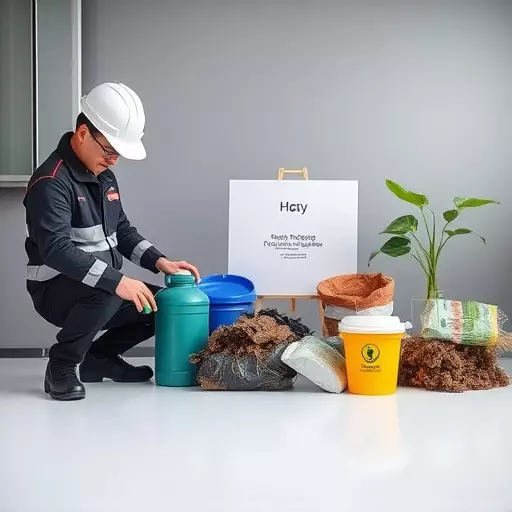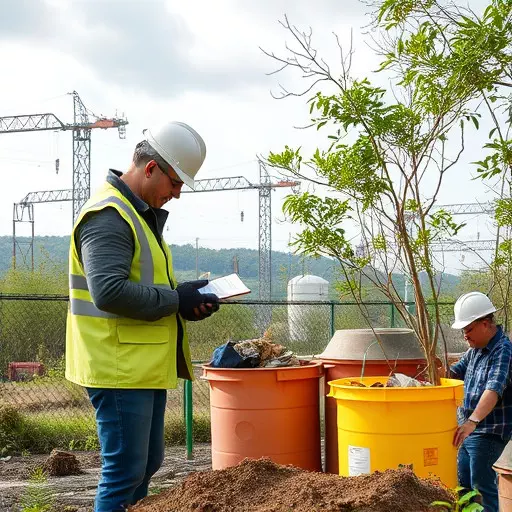Environmental compliance inspection is a vital process ensuring businesses adhere to strict regulations across water quality, air quality, waste disposal, energy use, and pollution control. Each industry faces unique challenges, with manufacturing under intense scrutiny for air emissions and agriculture for pesticide use. Hazardous waste management audits, a key component of Environmental, Social, and Governance (ESG) practices, evaluate the safe handling and disposal of hazardous substances according to EPA guidelines. Effective environmental risk management requires regular inspections, strategic planning with eco-friendly alternatives, enhanced recycling, and transparent communication. Case studies show that businesses can achieve sustainability milestones while adhering to stringent regulations through proactive measures and innovative practices like cutting-edge technologies.
In an era where sustainability is paramount, understanding Environmental, Social, and Governance (ESG) practices is crucial for businesses worldwide. This article provides a comprehensive overview of key ESG components, focusing on environmental compliance inspection, regulatory frameworks, and hazardous waste management audits. By exploring these aspects, we uncover strategies for effective environmental risk assessment and mitigation, drawing from real-world case studies demonstrating the achievement of stringent environmental standards across industries.
- Understanding Environmental Compliance Inspection: A Comprehensive Overview
- Unraveling Environmental Regulatory Frameworks Across Industries
- The Importance of Hazardous Waste Management Audit in ESG Practices
- Strategies for Effective Environmental Risk Assessment and Mitigation
- Case Studies: Success Stories in Achieving Strict Environmental Standards
Understanding Environmental Compliance Inspection: A Comprehensive Overview

Environmental Compliance Inspection plays a pivotal role in ensuring that businesses and organizations adhere to the stringent environmental regulatory frameworks in place. These inspections, conducted by regulatory bodies or independent auditors, meticulously scrutinize various aspects of a company’s operations, focusing on their impact on the environment. The scope includes but is not limited to water and air quality management, waste disposal practices, energy utilization, and compliance with pollution control measures.
A comprehensive Environmental Compliance Inspection involves a detailed review of documentation, facility tours, and interviews with key personnel. During these checks, auditors assess if the organization is adhering to permit conditions, implementing best available technologies, and effectively managing hazardous waste through regular audits. This process not only safeguards environmental health but also fosters responsible business practices, ultimately contributing to a sustainable future.
Unraveling Environmental Regulatory Frameworks Across Industries

Unraveling Environmental Regulatory Frameworks is crucial for understanding the diverse landscape of environmental compliance across industries. Each sector faces unique challenges and requirements when it comes to protecting the environment, from managing energy consumption to dealing with hazardous waste. For instance, manufacturing companies are often subject to stringent regulations around air quality and emissions control, while the agricultural industry must navigate rules governing pesticide use and water pollution prevention.
Environmental compliance inspection plays a vital role in ensuring these frameworks are followed. Regular audits, including those focused on hazardous waste management, help businesses identify areas for improvement and maintain adherence to regulatory standards. By staying informed about evolving environmental regulatory frameworks, industries can foster sustainable practices, mitigate risks, and contribute to a greener future.
The Importance of Hazardous Waste Management Audit in ESG Practices

In the realm of ESG (Environmental, Social, Governance) practices, hazardous waste management plays a pivotal role in ensuring corporate responsibility and environmental compliance. An integral part of this process is the hazardous waste management audit, which serves as a robust tool for evaluating and improving environmental performance. These audits delve into the comprehensive handling, storage, transportation, and disposal of hazardous substances, ensuring adherence to stringent environmental regulatory frameworks.
By conducting thorough environmental compliance inspections, these audits uncover potential gaps in waste management practices. They assess the effectiveness of implementation strategies outlined in Environmental Protection Agency (EPA) guidelines or other relevant authority standards. The audit process identifies areas where organizations can enhance their ESG performance, mitigate risks associated with non-compliance, and contribute to a sustainable future. It fosters transparency, enabling stakeholders to have trust in the organization’s commitment to environmental stewardship.
Strategies for Effective Environmental Risk Assessment and Mitigation

Effective environmental risk assessment and mitigation require a multi-faceted approach. Organisations should integrate comprehensive environmental compliance inspection routines into their operations, adhering strictly to relevant environmental regulatory frameworks. This involves regular audits that extend beyond surface-level adherence to include in-depth analysis of waste management practices, especially concerning hazardous materials.
Strategic planning for risk mitigation should encompass proactive measures like implementing eco-friendly alternatives to hazardous substances, improving recycling and waste segregation programs, and adopting sustainable sourcing practices. Continuous monitoring and reporting of environmental impacts, coupled with transparent communication about efforts and progress, are key to building a robust environmental stewardship culture within the organisation.
Case Studies: Success Stories in Achieving Strict Environmental Standards

In the pursuit of strict environmental standards, numerous organizations have emerged as success stories through dedicated efforts and innovative practices. These case studies showcase how businesses can achieve remarkable sustainability milestones while adhering to stringent regulatory requirements. One notable example involves a manufacturing giant that underwent a comprehensive environmental compliance inspection, revealing areas for improvement in their hazardous waste management processes. In response, the company initiated a thorough audit of its waste management systems, leading to a revolutionary overhaul.
Through this process, they implemented cutting-edge technologies and protocols for identifying, segregating, and responsibly disposing of hazardous materials. The result was a significant reduction in environmental impact, setting a benchmark for industry peers. Similarly, a renewable energy firm demonstrated its commitment to environmental stewardship by proactively embracing regulatory frameworks. By staying ahead of evolving standards, the company integrated sustainable practices into its core operations, ensuring minimal ecological footprints throughout its project lifecycles.


